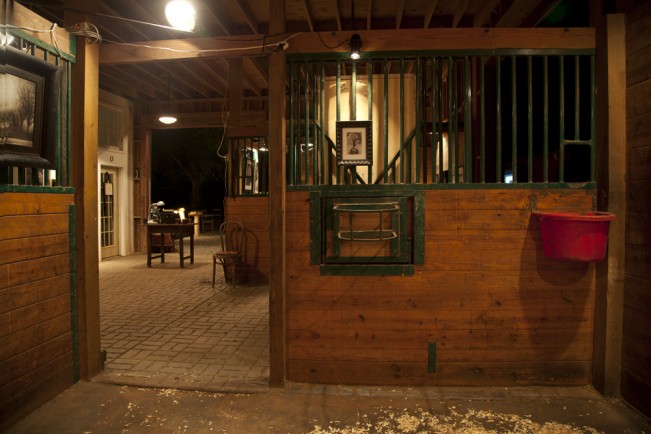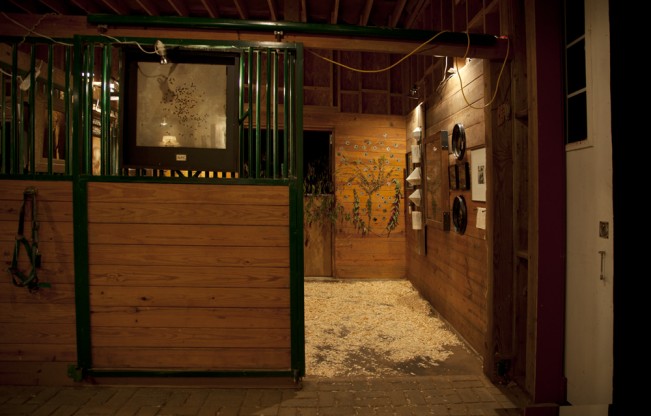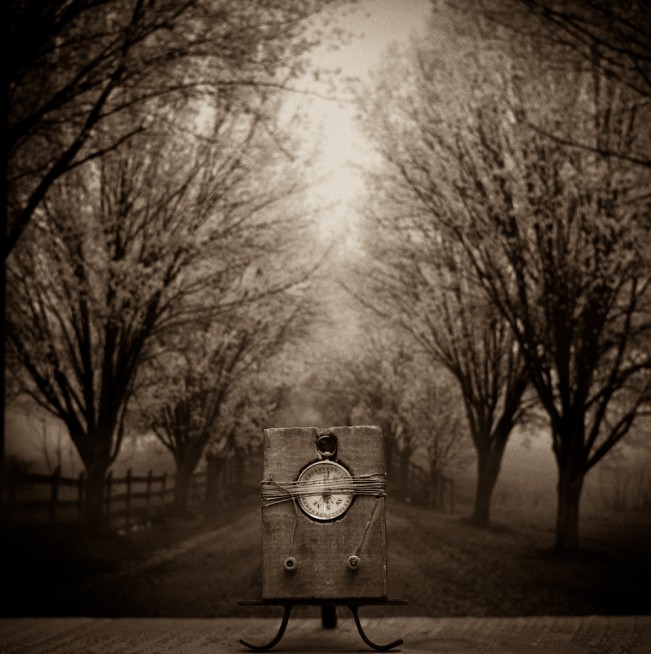The Posse: Time, Place, and Eternity: Flannery O’Connor and the Craft of Photography
This week, Lenscratch celebrates the SlowExposures Photography Festival.
One of the highlights of the SlowExposures Festival was the Posse’s exhibition, Time, Place, and Eternity: Flannery O’Connor and the Craft of Photography. The exhibition was constructed in Christine Curry’s horse barn as part of the Friday night soiree held at her home to celebrate the ShowExposures Festival. We arrived just as the sun was setting and in the distance was a stately home surrounded by big trees filled with strings of light. After picking up a cocktail, we made our way to the horse barn where the remarkable collective, The Posse, consisting of some of the most innovative and creative Southern photographers: Anne Berry, Ann George, Bryce Lankard, Lori Vrba, and S. Gayle Stevens, had crafted one of the most interesting and innovative exhibitions I’ve seen in a long while. With hay on the floor, we made our way through the horse stalls, reading Flannery O’Connor quotes and enjoying the unique approach to crafting, hanging, and presenting photographs. Dennis Kiel was an honorary Posse member, supporting and assisting with the exhibition. The group arrived in their own RV, setting up camp next to the barn. Needless to say, they had an amazing weekend!
 Time, Place, and Eternity: Flannery O’Connor and the Craft of Photography
Time, Place, and Eternity: Flannery O’Connor and the Craft of Photography
“The writer [photographer] operates at a particular crossroads where time and place and eternity somehow meet. His problem is to find that location” (59): A photographer need only substitute nouns: photographer for writer and photograph for story, to understand how Flannery O’Connor’s thoughts on the craft of writing apply to the art of photography. This year, which marks the fifty-year anniversary of her death, five southern photographers pay tribute to Flannery O’Connor by creating a pop-up exhibit in the barn at Split Oak Farm in Zebulon, GA as part of Slow Exposures, A Juried Exhibition Celebrating Photography of the Rural South. This exhibit follows the Posse’s 2013 pop up, Hay Now, which New York curator John Bennette called “the most brilliant installation ever to come down 109:” “In his words, “My breath was swept away. I said, ‘hallelujah, something wonderful has come to this town.” Time, Place, and Eternity explores five aspects in Flannery O’Connor’s writings that relate to the craft of photography: Grace, Mystery, Manners, Gesture, and Habit. We are opening the exhibit at Slow Exposures, and our goal is for it to travel to other venues throughout the coming year. – The Posse
GRACE: “I have discovered that what is needed [to make a story work] is an action that is totally unexpected, yet totally believable, and I have found that, for me, this is always an action which indicates that grace has been offered…. This is not a piece of knowledge that I consciously put into my stories; it is a discovery that I get out of them.” (118) As visual artists we struggle to create work that transcends the mundane and superficial, revealing what O’Connor calls “almost imperceptible intrusions of grace.” (112) The element of grace in photography is free. To get it one must let go of the mind’s conscious rules and fears.
MYSTERY: “…if the writer believes that our life is and will remain essentially mysterious…then what he sees on the surface will be of interest to him only as he can go through it into an experience of mystery itself. “(41) Grace is the gift; mystery is the result. A photograph becomes more than a fact when the element of mystery adds another layer of importance, making the image more complex. It is tangible and specific, but also universal because it has touched something true and essential, something “ which cannot be accounted for by any human formula.” (153)
GESTURE: The [writer of grotesque fiction] “is looking for one image that will connect or combine or embody two points; one is a point in the concrete, and the other is a point not visible to the naked eye, but believed in by him firmly, just as real to him, really, as the one that everybody sees.” (42)A photograph captures one moment in time. A gesture captured in this moment has the power to abstract. This gesture changes everything. The photograph captures a time and a place, but, more importantly, it touches eternity.
MANNERS: “You get the manners from the texture of existence that surrounds you. The great advantage of being a Southern writer is that we don’t have to go anywhere to look for manners; bad or good, we’ve got them in abundance. We in the South live in a society that is rich in contradiction, rich in irony, rich in contrast, and particularly rich in its speech.” (103) Slow Exposures, because of its commitment to the theme of the rural South, is the perfect venue to introduce this exhibit O’Connor expressed her fear that one day Southern writers would all be writing about men in “gray-flannel suits.” Cities in the South have become homogenized, but Southern manners are still to be found in rural areas. All five of us are products of the South. This shared Southern experience is a common thread in our work.
HABIT: “Art is the habit of the artist; and habits have to be rooted deep in the whole personality. They have to be cultivated like any other habit, over a long period of time, by experience…. It is a way of looking at the created world and of using the senses to as to make them find as much meaning as possible in things.” (101) The artist’s habit is reflected in his work. It is his way of working, his process, but also the sum of his beliefs and experiences. When the artist works from a place of truth and gratitude, the mystery and grace is apparent in the work. This gift is a responsibility.

white queen black queen, self portrait wet plate tintype diptych, 2 five ” plates handmade camera and handmade single element lens. ©S.Gayle Stevens
All quotes from Fitzgerald, Sally and Robert ed. Flannery O’Connor: Mystery and Manners. The Noonday Press, NY, 1961
Anne Berry: Anne Berry was born in Atlanta, Georgia. She grew up in Atlanta, the mountains of north Georgia, the Flint River in south Georgia, and on Georgia’s costal barrier islands. The appreciation for places unspoiled by development is central to her vision. Also essential to Anne is her understanding of animals. She photographs animals to get people to truly look at them and to consider their value and their place in the world. Anne attended Sweet Briar College (BA) and the University of Georgia (MA). She is a PhotoLucida Critical Mass 2012 and 2013 Top 50 and a 2012 Clarence John Laughlin Award finalist. She is represented by the Catherine Couturier Gallery in Houston, and her work is exhibited and published internationally. Currently Anne is working on Behind Glass, a collection of images of primates in captivity. A very limited edition book of Anne’s images, which includes a photogravure, can be ordered through North Light Press.
Ann George: Ann George grew up in a small Louisiana town with people and places that grounded her roots deep into the southern soil her heart into the southern personality. She is a self-taught visual artist who found photography as a means to express her native Louisiana as well as narratives, stories and literature that moves her. She melds paint pixels and paper as well as photogravures to create photographic fusions that call to her vintage eye. Her Project “The Three Chapters Of Illumination” was represented in the National Argentina Photography Festival in its entirety and has been shown throughout the United States. Her work has been acquired in many private collections, published in numerous periodicals and is represented by Nevares Fine Art, NY,NY Lionheart Gallery NY. Ann’s critics have compared her work to historical photographers as her approach yields a vintage pictorial influence and portrays the role of inspirational storyteller through imagery
Bryce Lankard: I have been making photographs since I was a teenager, in a time before cell phone cameras and the like. Most of my work focuses on the South, where I grew up as a southern child of northern parents. This search for identity has lead me to draw inspiration from the great southern writer Walker Percy, with whom I share both North Carolina and New Orleans roots, and now I am involved in a collaboration (with the “Posse”) that has chosen another icon, Flannery O’Connor and her themes, as a guiding light. I have long been attracted to subjects that are simultaneously familiar and foreign. I have looked with wonder on an America that has catapulted through the end of a millennium while clinging for dear life to all its old idiosyncrasies.
S. Gayle Stevens: S. Gayle Stevens has worked in antiquarian photographic processes for over fifteen years. Her chosen medium is wet plate collodion for its fluidity and individuality. She exhibits extensively across the United States, United Kingdom, the Netherlands and China. Ms. Stevens received an MFA from the School of the Art Institute of Chicago in 1999. She is an educator, speaker, juror, curator and an active member of the photographic community. Named one of the Critical Mass Top Fifty Photographers for 2010, she received second place in the Lens Culture International Exposure Awards in 2011 and was named a finalist for the Clarence John Laughlin Award in 2012. Her work has been featured in Fraction, Square, Shots, Diffusion, B + W Photography, South by Southeast and Fuzion magazines and in the recently published book Inventing Reality, New Orleans Visionary Photography. North Light Press published a book of Stevens’ work, Calligraphy, in their 11 + 1 Signature series. Christopher James will feature her work in the third edition of The Book of Alternative Photographic Processes. Stevens’ work is widely collected and is part of the permanent collection of the Ogden Museum of Southern Art, the New Orleans Museum of Art, the Rockford Museum of Art and the Center for Fine Art Photography and recently the University of New Mexico Art Museum, among others. A member of the Posse photo collective, she divides her time shooting in Pass Christian, Mississippi and Downers Grove, Illinois, where she resides. Stevens is represented by Tilt Gallery, Catherine Couturier Gallery, and Gallery Kayafas.
Lori Vrba: Lori Vrba is a native Texan now residing in North Carolina. She is a self-taught, film-based artist committed to the traditional wet darkroom. Her photographs as well as her assemblage work have a feminine, narrative component often addressing themes of time, place, memory, loss and desire. She considers her exhibition installations as an important extension of the work itself with recent examples of such in New Orleans, Atlanta, Santa Barbara and Houston. She is represented by Catherine Couturier Gallery in Houston, Texas and Wall Space Gallery in Santa Barbara, California. Her work is held in the permanent collections of the Lishui Photography Museum in China and The Museum of Fine Arts Houston.
All content on this site cannot be reproduced without linking to Lenscratch and without the permission of the photographer.
Posts on Lenscratch may not be reproduced without the permission of the Lenscratch staff and the photographer.
Recommended
-
Carolina Baldomá: An Elemental PracticeJanuary 5th, 2026
-
Time Travelers: Photographs from the Gayle Greenhill Collection at MOMADecember 28th, 2025
-
Suzette Dushi: Presences UnseenDecember 27th, 2025
-
Ragne Kristine Sigmond: Portraits of Painterly LightDecember 2nd, 2025






















































































